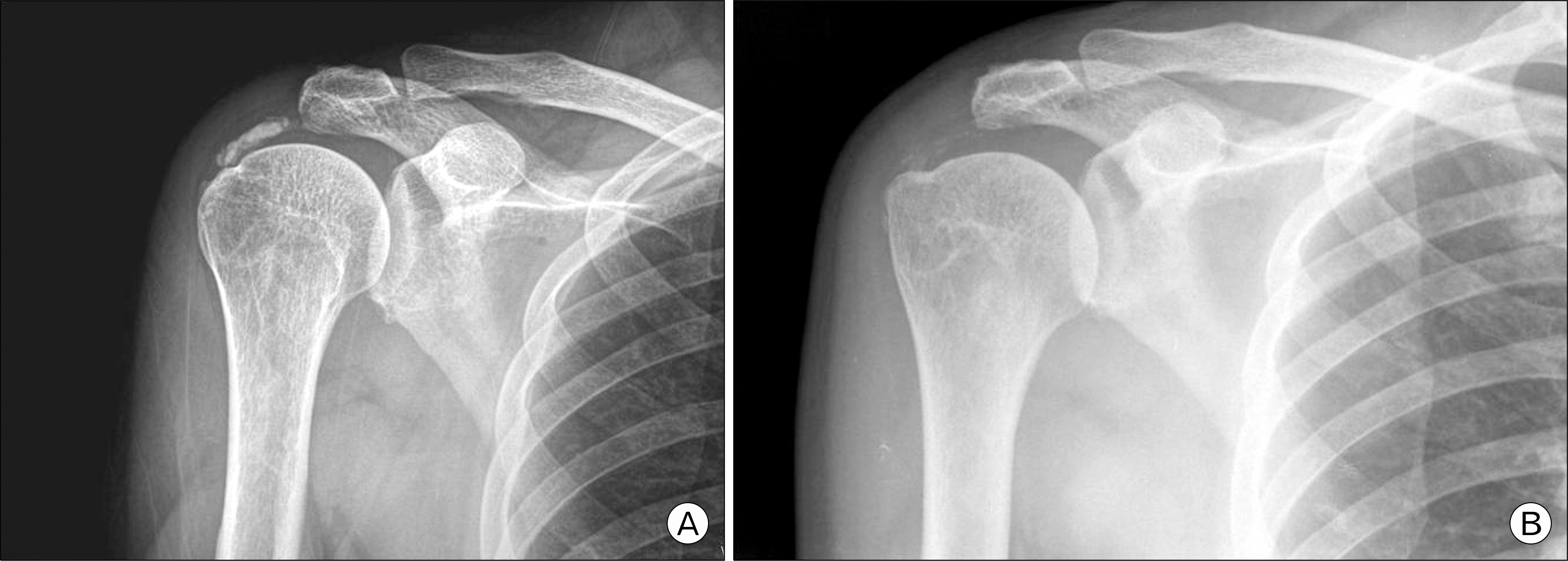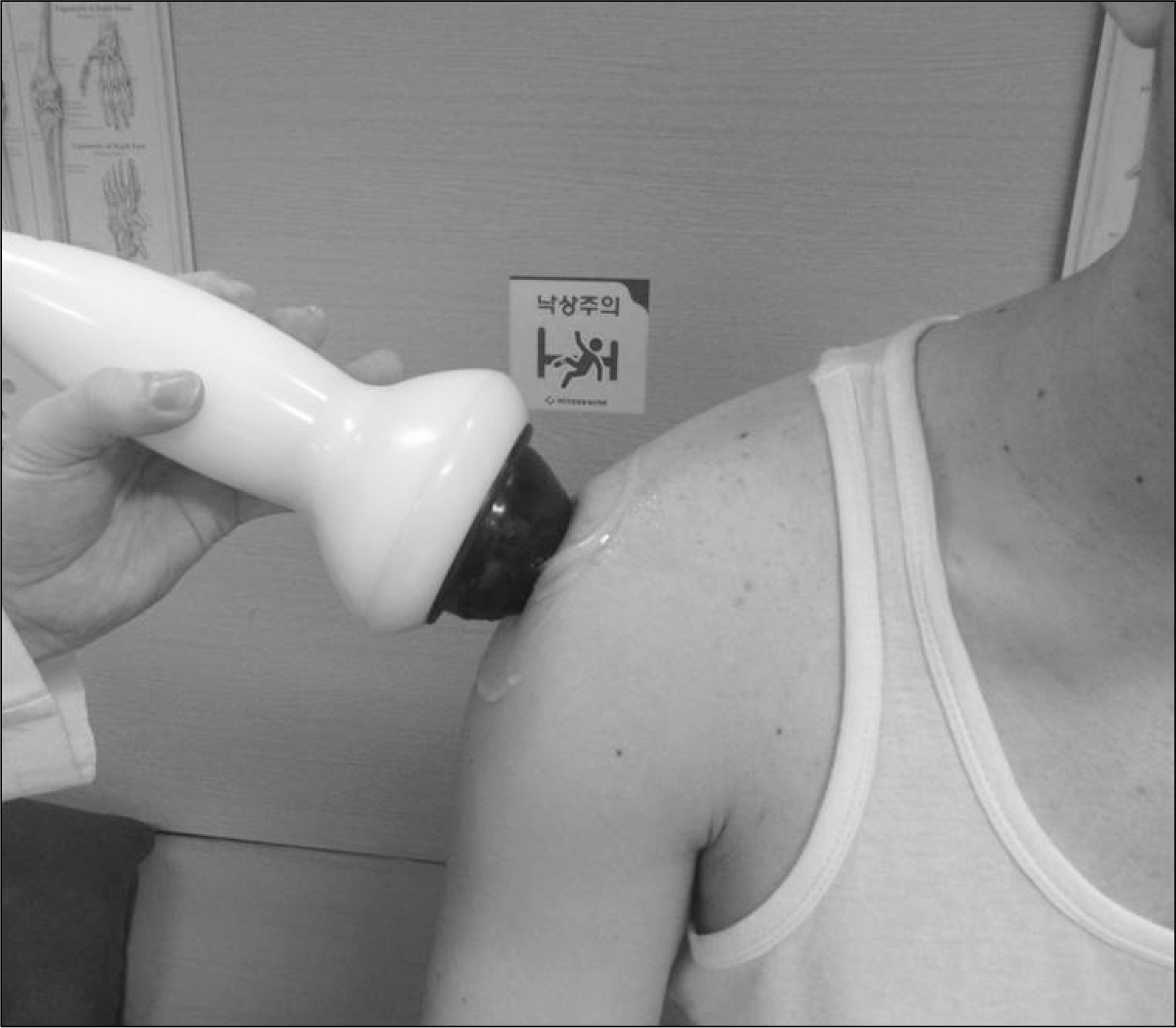Abstract
To evaluate the functional and radiologic outcomes of extracorporeal shock wave therapy (ESWT) in shoulders with chronic calcific tendinitis. We report a retrospective study to compare the outcome after ESWT (group l, 15 cases) with the effect of medication treatment (group 2, 15 cases) in patients with chronic calcific tendinitis. Patients were aged 42 to 58 years, mean of 48 years and treated with extracorporeal shock waves or medication from September 2012 to May 2014. The ESWT was performed six cycles of shock waves, weekly treatment for the three cycles and the rest cycles after 2 weeks of pause. In the same period, there were 12 women and 3 men treated with medication treatment for calcific tendinitis. The clinical outcomes were evaluated according to Constant and Murley score and pain visual analogue scale. Radiologic evaluation was performed to confirm disintegration of calcific deposits 3 months and 6 months after treatment. Clinical outcomes were significantly improved in ESWT group, and there was significant difference between ESWT group and medication group. In radiographic evaluation, the calcific deposit was significantly decreased in ESWT group. ESWT therapy is more effective to achieve functional improvement and to alleviate pain in the patients with calcific tendinitis of the shoulder.
REFERENCES
1.Bosworth BM. Calcium deposits in the shoulder and subacromial bursitis: a survey of 12,122 shoulders. JAMA. 1941. 116:2477–82.
2.Ark JW., Flock TJ., Flatow EL., Bigliani LU. Arthroscopic treatment of calcific tendinitis of the shoulder. Arthroscopy. 1992. 8:183–8.

4.Refior HJ., Krodel A., Melzer C. Examinations of the pathology of the rotator cuff. Arch Orthop Trauma Surg. 1987. 106:301–8.

5.Milone FP., Copeland MM. Calcific tendinitis of the shoulder joint. Presentatin of 136 cases treated by irradiation. Am J Roentgenol Radium Ther Nucl Med. 1961. 85:901–13.
6.Gerdesmeyer L., Wagenpfeil S., Haake M, et al. Extracorporeal shock wave therapy for the treatment of chronic calcifying tendonitis of the rotator cuff: a randomized controlled trial. JAMA. 2003. 290:2573–80.
7.Moseley HF. The natural history and clinical syndromes produced by calcified deposits in the rotator cuff. Surg Clin North Am. 1963. 43:1489–93.
8.Parlier-Cuau C., Champsaur P., Nizard R., Wybier M., Bacque MC., Laredo JD. Percutaneous treatments of painful shoulder. Radiol Clin North Am. 1998. 36:589–96.

9.Gimblett PA., Saville J., Ebrall P. A conservative management protocol for calcific tendinitis of the shoulder. J Manipulative Physiol Ther. 1999. 22:622–7.

10.Green S., Buchbinder R., Glazier R., Forbes A. Systematic review of randomised controlled trials of interventions for painful shoulder: selection criteria, outcome assessment, and efficacy. BMJ. 1998. 316:354–60.

11.Philadelphia Panel. Philadelphia Panel evidence-based clinical practice guidelines on selected rehabilitation interventions for shoulder pain. Phys Ther. 2001. 81:1719–30.
12.Ebenbichler GR., Erdogmus CB., Resch KL, et al. Ultrasound therapy for calcific tendinitis of the shoulder. N Engl J Med. 1999. 340:1533–8.

13.Ogden JA., Alvarez RG., Levitt R., Marlow M. Shock wave therapy (Orthotripsy) in musculoskeletal disorders. Clin Orthop Relat Res. 2001. 387:22–40.

14.Gartner J., Simons B. Analysis of calcific deposits in calcifying tendinitis. Clin Orthop Relat Res. 1990. 254:111–20.

15.Rompe JD., Hope C., Kullmer K., Heine J., Burger R. Analgesic effect of extracorporeal shock-wave therapy on chronic tennis elbow. J Bone Joint Surg Br. 1996. 78:233–7.

16.Rompe JD., Zoellner J., Nafe B. Shock wave therapy versus conventional surgery in the treatment of calcifying tendinitis of the shoulder. Clin Orthop Relat Res. 2001. 387:72–82.

17.Birnbaum K., Wirtz DC., Siebert CH., Heller KD. Use of extracorporeal shock-wave therapy (ESWT) in the treatment of non-unions: a review of the literature. Arch Orthop Trauma Surg. 2002. 122:324–30.
18.Rompe JD., Schoellner C., Nafe B. Evaluation of low-energy extracorporeal shock-wave application for treatment of chronic plantar fasciitis. J Bone Joint Surg Am. 2002. 84:335–41.

19.Wang CJ., Chen HS. Shock wave therapy for patients with lateral epicondylitis of the elbow: a one- to two-year follow-up study. Am J Sports Med. 2002. 30:422–5.
20.Loew M., Daecke W., Kusnierczak D. The effects of extracorporeal shock wave application (ESWA) in treatment of calcifying tendinitis of the shoulder. J Bone Joint Surg Br. 1997. 79(Suppl 2):202–3.
21.Schmitt J., Haake M., Tosch A., Hildebrand R., Deike B., Griss P. Low-energy extracorporeal shock-wave treatment (ESWT) for tendinitis of the supraspinatus: a prospective, randomised study. J Bone Joint Surg Br. 2001. 83:873–6.
22.Speed CA., Richards C., Nichols D, et al. Extracorporeal shockwave therapy for tendonitis of the rotator cuff: a double-blind, randomised, controlled trial. J Bone Joint Surg Br. 2002. 84:509–12.
23.Haake M., Deike B., Thon A., Schmitt J. Exact focusing of extracorporeal shock wave therapy for calcifying tendinopathy. Clin Orthop Relat Res. 2002. 397:323–31.

24.Wang CJ. An overview of shock wave therapy in musculoskeletal disorders. Chang Gung Med J. 2003. 26:220–32.
25.Wang CJ., Wang FS., Yang KD. Biological effects of extracorporeal shockwave in bone healing: a study in rabbits. Arch Orthop Trauma Surg. 2008. 128:879–84.

Fig. 2.
(A) Initial plain X-ray of calcific tendinitis patient. (B) After 6 months, follow-up X-ray of extracorporeal shock ave therapy therapy patient for calcific tendinitis.

Table 1.
Demnographic factors




 PDF
PDF ePub
ePub Citation
Citation Print
Print



 XML Download
XML Download